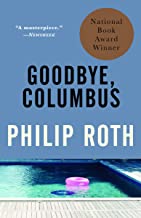Goodbye, Columbus by Philip Roth 1959
Philip Roth was 26 years old when his first collection of short stories won the National Book Award for Fiction in 1959. Though I’m sure I read this book some years ago, and probably this very volume, a Bantam 75 cents paperback, reading these stories today was a revelation and an emotional experience.
Roth appears to have burst upon the scene with all of the writer’s skills that made him one of the most prolific, honored, and controversial authors of the late 20th/early 21st C. Having read almost all of his fiction, I feel that ‘Goodbye, Columbus’ shows none of the immaturity and contrived prose usually associated with an author’s first or early work. These six stories are gems. Each one of them took me back to my own childhood and early adolescence in the 1950’s and ’60’s. The beauty is in the details as when a character in the final story, Eli the Fanatic extols the peace and tranquility of his suburban New Jersey town by exclaiming that ‘I size people’s feet with an x-ray machine, for God’s sake’. I still remember seeing the ghostly outline of my own feet in Gotskind’s shoe store on Lake Street in 1952 Chicago. And then there’s the Patemkins in the eponymous story with their plumbing supply business, Leo Epstein’s paper bag business, and Neil Klugman’s parents who moved from inner city Newark to Arizona for their asthma—these are all people that I knew growing up in Chicago. Brenda Patemkin’s father’s letter reminding his Radcliffe daughter to bring her friend Linda home for Thanksgiving repeated itself in reality during my four Thanksgiving’s at my friend Hal Krents’ home in Scarsdale where we traveled from Harvard. And on and on. Leo Patemkin, Brenda’s step-uncle, inebriated and forlorn after Brenda’s brother’s wedding, rues his days as a light bulb salesman, and my own part time job while in medical school was selling light bulbs! I still have vivid memories of Saturday nights while in Ann Arbor driving to Ypsilanti with Susan to view my bulbs in the windows of Ernst Electric. And what was the band playing at the Patemkin wedding? a medley from My Fair Lady which also loomed large for my own wedding in 1968.
Roth managed to capture my world with all of its innocence and sadness and with a large helping of humor. Here’s how he describes Gloria Feldman, the wife of Ron Patemkin’s friend: “….a nervous, undernourished girl who continually looked down the front of her gown as though there was some sort of construction project going on under her clothes.” Could any image conveyed in words be more perfect?
Roth is often criticized for his misogyny as well as his self-hating anti-semitism, and there is certainly enough negative emotion directed at the Jewish stereotypes which fill these pages. From Brenda’s nose job to her father’s business ethics, from Leo Epstein’s description of his wife Goldie, and on and on, the Jews don’t come off as enlightened people of the book. On the other hand, Roth is telling the story of an assimilating people in the new promised land of America as exemplified by the horror of the Jewish citizens of Woodenton, NY when a yeshiva is established in an old home there and is populated by refugees from Hitler’s Europe including an orthodox man who unsettles the assimilating Jews by walking into town in his black hat and tsitsis.
Roth is Roth, from ‘Goodbye, Columbus'( and by the way, I never realized that Columbus did not refer to the 1492 explorer but to Ohio State University where Brenda’s brother, Ron, played basketball!) to his final trilogy of Newark, NJ novels. he remained true to his ethic of writing what he saw. The failure to award him the Nobel Prize ranks with my anger about Nabokov not receiving it as well. A prime exemplar of the short story, this is a volume well worth reading or re-reading.



